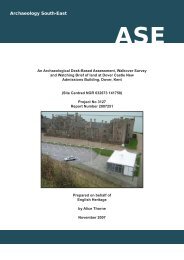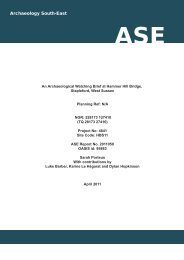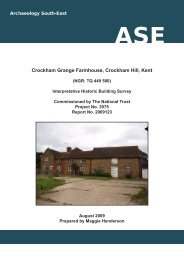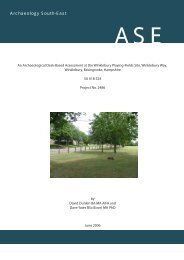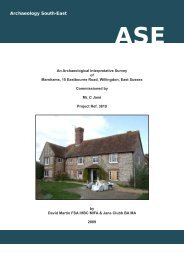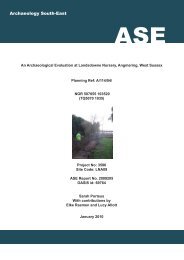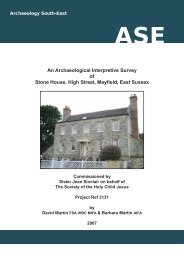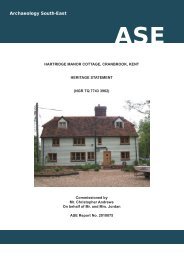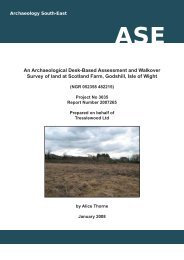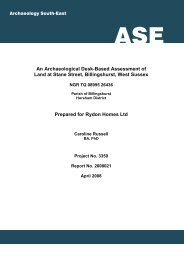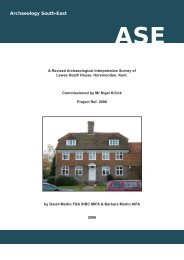ASE front cover - Archaeology South-East
ASE front cover - Archaeology South-East
ASE front cover - Archaeology South-East
You also want an ePaper? Increase the reach of your titles
YUMPU automatically turns print PDFs into web optimized ePapers that Google loves.
<strong>Archaeology</strong> <strong>South</strong>-<strong>East</strong>2008058: Holbury Infants School, Holbury, Hampshireassemblage is of interest for the evidence it contains for late Roman tilemakingtechniques. Some of the tegulae have clearly been formed in thetraditional manner, i.e. with a sanded base and a smooth, flanged upperface. Several of the tegulae in fabric R3 are of this type, with smooth upperface, sanded base and tall thin flanges. One upper cutaway survives; this isknife-cut, confirming that the tile was moulded with the top surfaceuppermost. However, certain other tegulae have smooth bases, squaredflanges and sanded upper faces and cutaways, all of which are featuresconsistent with manufacture in an inverse mould (Warry 2006, 7-34). Twofragments with lower cutaways survive (fabrics R1/R2); both are mouldedand of Warry’s type D (Warry 1996, 3-4). A single upper cutaway in fabricR2 survives in part; a clay lip on the cutaway was probably formed by amould insert. A similar feature is visible on the upper cutaway of a tile infabric R3 which also has other features of a tile made in an inverted mould.These tiles can be dated with some confidence to the 3rd or early 4thcentury (pers. comm Peter Warry). Comparison of the dimensions of thecutaways and the shapes of the corners indicates that the tiles were madein different moulds. However, the small number of fabrics present and thesimilarity of the style/methods of manufacture suggest that most of the tileswere probably made at about the same time. Although almost certainly reusedon the site, they are likely to have come from one or more 3rd or early4th century structures in the area.Other features noted on tegulae are a nail-hole at the end of one tile, formedbefore the tile was fired. Although more frequent in the later Roman period,nail-holes occur in all periods and are not in an assemblage of such smallsize an indicator of late date. Another, in fabric R1, appears to have thin redslip on the surface; this may be natural or an attempt to colour the tile.Very small quantities of imbrex were recorded; they occur only in the fill ofprobable quarry pit [1004] and, sooted, in association with [1057], most likelya hearth.5.2.6.3 Box flues (fabrics R2, R3): Three abraded fragments of box flue or hollowvoussoir tile came from the fill of probable quarry pit [1009]. All are keyedwith bands of combing.5.2.7 Markings on tiles5.2.7.1 Signature marks, made with the fingers in the wet clay, were noted on fourtiles. Single linear marks occur on two bricks (fabrics R1, R2), and triplearcs on a brick and a tegula (fabric R1). The signature on the tegula isoverlaid by the imprint of angular object, perhaps the blade of the knife usedto trim the tile.5.2.8 Daub5.2.8.1 A small amount of very abraded light orange sandy daub, similar to Romanfabrics R1 and R2, came from the fill of probable quarry pit [1009].5.2.9 The post-medieval assemblage5.2.9.1 Roof tiles make up less than 2% of the total assemblage (by weight andfragment count). The only tile type represented is post-medieval peg tile28© <strong>Archaeology</strong> <strong>South</strong>-<strong>East</strong>



